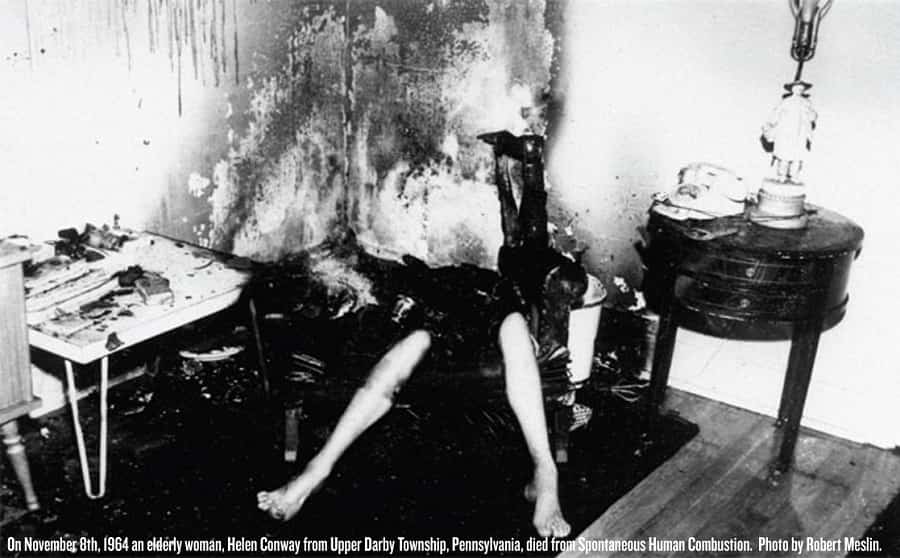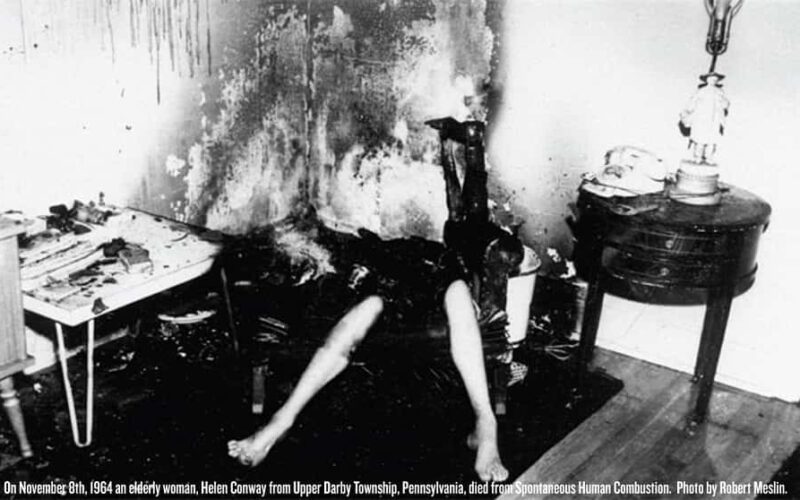Is Spontaneous Human Combustion Real? Understanding the Science Behind This Mystery

Over the years, reports of spontaneous human combustion (SHC) have popped up worldwide. But can a human body actually catch fire all by itself?
In December 2010, a 76-year-old man named Michael Faherty was found dead in his home in Galway, Ireland. His body had been badly burned, but investigators could not find any usual causes, like flammable liquids or suspicious activity. They even ruled out the nearby fireplace as a cause. After looking at all the clues, the coroner stated that Faherty’s death was due to spontaneous human combustion. This decision created a lot of debate. Many people are curious about this strange phenomenon, wondering if it’s real or not.
What Is Spontaneous Human Combustion?
The idea of spontaneous human combustion dates back to the 18th century. In 1744, Paul Rolli, a member of the Royal Society of London, wrote about it in a scientific journal. He explained it as a process where a human body seems to catch fire because of heat created inside the body, without any outside spark.
This concept gained attention, especially during the Victorian era, and became linked with people who drank a lot of alcohol. For example, Charles Dickens, a famous writer, included a case of SHC in his 1853 novel *Bleak House*. In the story, a character named Krook, who drinks heavily, mysteriously catches fire and dies. Some scientists criticized Dickens for this story, saying SHC was not real. But public interest in SHC kept growing, and even authors like Mark Twain and Herman Melville mentioned it in their works.
Today, most scientists still doubt the reality of SHC, despite reports of around 200 possible cases from different parts of the world.
Cases of Spontaneous Human Combustion
One of the earliest cases on record is from the 1400s in Milan, Italy. A man named Polonus Vorstius was said to have suddenly caught fire in front of his parents after drinking strong wine. Alcohol seemed to play a role in this incident, as he reportedly belched flames after his drink.
In another case, the Countess Cornelia Zangari de Bandi of Cesena in Italy met a similar fate in 1745. She went to bed as usual, but the next morning, her maid found her in a pile of ashes. Only her head and lower legs were partially left, and strangely, two candles nearby were untouched.
Over the years, other cases of supposed spontaneous combustion have been reported in different countries, from Pakistan to the United States. In these cases, experts couldn’t find another explanation, and there were some common factors:
1. Fire Limited to the Victim: The fire usually only affects the person and the area around them, without spreading far.
2. Burns Above and Below the Body: There is often damage right above and below the person, but not elsewhere in the room.
3. Remaining Body Parts: Typically, the torso turns to ash, but limbs like arms and legs remain partially unburned.
But even with these strange similarities, scientists believe there are logical explanations for these events.
Possible Scientific Explanations
Despite the lack of other clear causes of death, most scientists don’t believe that SHC is truly spontaneous or internal. Instead, they offer several explanations:
1. Fires That Stop Naturally
One reason scientists are skeptical of SHC is that fires can sometimes be self-limiting. This means they die out on their own when they run out of fuel. In cases of supposed SHC, human body fat may act as fuel. Because fires usually burn upward instead of outward, it’s not unusual to find a burned body in an otherwise mostly untouched room.
2. The Wick Effect
A key concept explaining SHC is called the “wick effect.” This is similar to how a candle burns, where a flame uses flammable wax to keep burning. In this case, human bodies could work like candles. The person’s clothing or hair acts as the wick, and body fat provides the fuel.
When a person’s body burns, the fat under their skin can melt and soak into their clothes. This fat keeps feeding the flame, allowing it to burn at high temperatures until there’s nothing left to fuel it. Eventually, the fire goes out on its own, leaving only ashes, which is often seen in SHC cases.
3. How the Fire Starts
The big question is: what causes the fire in the first place? Most scientists think that a nearby ignition source starts these fires. For example, many people found in these cases are elderly, alone, and either sitting or lying near something that could start a fire, like a cigarette or a fireplace.
In some cases, the person was last seen drinking alcohol. During the Victorian era, people believed that alcohol, a flammable substance, might cause some kind of chemical reaction in the stomach, leading to SHC. Today, scientists think it’s more likely that alcohol affects people’s awareness. Some victims might have been drinking heavily and fell asleep with a lit cigarette, which could have started the fire.
Many of these cases involve older people who might have had a stroke or heart attack before the fire began. For example, if someone becomes unconscious while holding a cigarette, they could accidentally set themselves on fire. In these situations, there’s no one else around to put out the flames, so the body burns and leaves behind a pile of ash, making it seem like a mystery.
Why So Many People Believe in Spontaneous Human Combustion
There’s a reason why people are fascinated by SHC, even though science doesn’t support it. First, the idea that a body can suddenly ignite without warning is both scary and intriguing. The mystery of it makes people curious and keeps them guessing.
Second, SHC cases usually lack witnesses. Since most cases involve people who were alone, no one was there to see what actually happened. This lack of evidence can make the fires seem more mysterious.
Finally, books, movies, and media have popularized SHC, making it seem more real. When people hear about SHC in fictional stories or news reports, it can fuel their imagination and make them wonder if it could really happen.
The Science Says: No Mystery
While stories of SHC are mysterious and have intrigued people for centuries, science offers logical explanations. With knowledge about how fire works, the wick effect, and the role of body fat, experts believe that SHC cases are likely caused by accidents. Elderly people, who are more prone to health issues or sleep near open flames, are the usual victims in these cases.
In the end, spontaneous human combustion may sound terrifying, but it’s likely a combination of fire science and tragic accidents. Scientists say SHC is simply a myth, a story that continues to intrigue but has no real basis in biology or chemistry. So while the mystery of spontaneous human combustion may keep sparking interest, it remains just that—a mystery, with answers firmly rooted in science rather than the supernatural.
FAQ on Spontaneous Human Combustion
What is spontaneous human combustion (SHC)?
Spontaneous human combustion refers to the belief that a person can catch fire suddenly and burn from within, without any obvious external source of ignition. In such cases, the victim’s body is often heavily burned, while nearby surroundings are left relatively untouched. Scientists believe there are other causes at play, like the “wick effect,” rather than any mysterious or spontaneous internal fire.
Are there real cases of spontaneous human combustion?
Yes, there are over 200 reported cases that have been labeled as spontaneous human combustion. However, experts argue that these incidents are likely due to accidental fires that occur without witnesses. In many cases, the victims were near a possible ignition source, like a cigarette or fireplace, when the incident occurred.
What is the wick effect?
The wick effect is a scientific explanation for SHC-like cases. In this effect, a person’s clothing acts like a candle wick, and body fat serves as fuel. If a small flame (from a cigarette, for example) ignites the clothes, the body fat can melt and soak into the clothing, keeping the fire going until much of the body burns. This can lead to the high levels of burning found in SHC cases, without affecting much of the surrounding environment.
How do scientists explain supposed cases of SHC?
Scientists believe that most cases involve an external ignition source, such as a cigarette or nearby fire. Additionally, most cases occur when the person is alone, often elderly or with limited mobility, making it difficult to respond to an accidental fire. Body fat and the wick effect help explain how a fire could continue to burn intensely without spreading widely.
Is there any scientific evidence for SHC being a real phenomenon?
No, there is no scientific evidence supporting SHC as a real, spontaneous process caused by internal chemical reactions. Studies show that the reported cases can generally be explained by known fire behavior, the wick effect, and accidental circumstances.
Why does SHC often involve elderly individuals?
Many SHC cases involve elderly people who may have limited mobility or health conditions, making them more vulnerable. Additionally, age-related health problems like strokes or heart attacks could leave someone unconscious, causing them to drop a cigarette or not react quickly to a small fire.
Does alcohol consumption cause spontaneous human combustion?
While alcohol doesn’t cause spontaneous combustion directly, many historical SHC cases involve people who were drinking. Alcohol might increase the risk of accidental fires by affecting judgment or causing drowsiness. The Victorian belief was that alcohol made the body more flammable, but science has debunked this idea.
Are there other fire-related phenomena that are mistaken for SHC?
Yes, self-limiting fires, where flames die out once they run out of fuel, could appear mysterious in SHC cases. Fires usually burn upward rather than outward, which may result in a body being severely burned without extensive room damage. Additionally, the effects of smoke, heat, and airflow can make certain fires seem unusual.
Has anyone ever witnessed a case of spontaneous human combustion?
No documented case of SHC has had direct witnesses. Nearly all reported cases happen when a person is alone. The lack of witnesses, combined with unusual fire patterns, contributes to the mystery surrounding SHC.
Why is spontaneous human combustion still believed by some people?
SHC remains a popular topic in literature, movies, and folklore, which keeps the mystery alive. Historical accounts, media portrayals, and the seemingly unusual circumstances of SHC cases all contribute to people’s fascination with it, even though science offers logical explanations.
Can I prevent spontaneous human combustion?
Since SHC is not scientifically supported as a real phenomenon, there is no specific way to prevent it. To reduce the risk of accidental fires, avoid smoking while sleepy or near flammable materials, and ensure fireplaces are used safely. Being mindful of fire safety is the best precaution.
Does SHC have any supernatural or paranormal connections?
Some people believe SHC is connected to supernatural forces, but scientists attribute these cases to known fire behaviors and circumstances. The fascination with SHC’s mystery has led to many theories, but there is no evidence linking it to anything paranormal.

